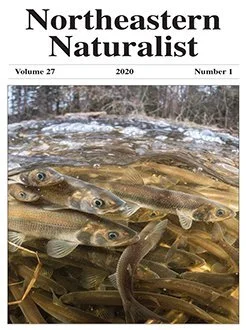Below is a list of my up-to-date peer-reviewed publications including a short abstract of each article. Links to publicly available copies of each manuscript are also provided where possible.
Canadian Journal of Fisheries and Aquatic Sciences
This was one of the coolest projects I’ve ever participated in. The data were amazingly neat to look at! Atlantic halibut are a prized commercial fish species and display long-distance migratory behaviour. This study used pop-up satellite archival tags and fancy math (for you stats nerds: Hidden Markov Models) to track the nearly year-long movements of halibut captured in PEI. These tags record data every 15 seconds so we had millions of data points! We could even see “spawning rises” in the data. We revealed that halibut in the southern Gulf of St. Lawrence display strong migratory behaviour, but the most important finding was that there appear to be two contingents: one that spawn off Cape Breton and another that migrate and spawn closer to Quebec’s Anticosti Island. Another important finding was that these fish move among different management zones during the year, especially during spawning. This (and other tagging data in the paper) is now evidence that Atlantic halibut in the Gulf of St. Lawrence should be managed as one continuous population.
Canadian Journal of Fisheries and Aquatic Sciences
This study combined acoustic telemetry with otolith microchemistry to reveal migratory behaviour in anadromous rainbow trout (steelhead) on Prince Edward Island. Rainbow trout spent most of their time in tidal (brackish) waters, occasionally making jaunts into full ocean/saltwater environments, and making periodic movements into freshwater (e.g., to spawn, but also at other times). Occupancy in full salt, tidal, and freshwater habitats differed for trout monitored in different systems. Overall, partial residency (of a particular habitat) was a shared characteristic among each of the trout studied. Frequent movements back and forth between habitats suggests that rainbow trout have an exceptional ability to quickly adapt to changes in salinity. They’re remarkable fish!
A multi-species analysis of fish passage at four Prince Edward Island fishways. Main take-home points: brook trout performed exceptionally well in comparison to rainbow smelt; rainbow smelt are tough to pass, but low-slope and low between-pool drop heights in pool-and-weir fishways appear to improve passage success; fishways designed specifically for salmonids (like brook trout) appear detrimental to passage of other migratory species like rainbow smelt and alewife.
Anadromous fishes are important vectors of nutrient transport from the sea to freshwater. Here, we illustrate an example of this with rainbow smelt in a coastal Prince Edward Island river. Our results show multiple trophic levels within a stream food web receive marine-derived nutrients, including important fatty acids such as omega-3s. We posit the most important vector of nutrient transport is via rainbow smelt eggs.
Transactions of the American Fisheries Society
“If you can pass a smelt you can pass anything” is a saying used by some fisheries biologists in Atlantic Canada to address concerns related to fish passage in the region. The thinking being, if you can pass a really “poorly” swimming fish like a rainbow smelt around dams, you should be able to pass anything. Here, we assessed rainbow smelt passage at a dual fishway complex, comparing passage between two different fishway designs at the same dam. We also assessed modifications to improve attraction. Ultimately, rainbow smelt were shown to pass a nature-like fishway, but not a pool-and-weir structure designed specifically to pass brook trout. Our modifications also did not work, stressing the importance of correctly locating fishway entrances at the construction phase of a project.
Also the cover image for this issue happens to be one of my photos!
River Research and Applications
Fishes exhibit discrete behavioural types (e.g., bold vs. shy) that have been linked to a number of fitness related activities. Here, we assess behavioural type in rainbow smelt within the context of passage at a nature-like fishway. Our aim was to determine the influence of individual behavioural type on successful passage. Our findings indicated no such effect, which is actually a good thing given that fishways ideally should allow passage of all phenotypes!
This is perhaps the paper I am most proud of. Here we show the first conclusive evidence of recruitment to the adult life stage of Lake Michigan lake trout in over 50 years of population recovery efforts. We used stable isotope analysis to show that isotopic signatures indicating natal origins of suspected wild adults do not match signatures of hatchery-reared fish, and also eliminated Lake Huron migrants as the source of this putative wild group of fish.
Environmental Biology of Fishes
The advent of high resolution acoustic transmitter technology allows us a detailed view of a tagged fish’s life. Here, we applied acceleration-sensing acoustic transmitters to determine the summer behaviour of muskellunge in an eastern Canadian river system. We show that, not surprisingly, muskellunge are rather sedentary, but distinct daily activity (as evidenced by acceleration measurements) patterns emerge. As a muskellunge angler myself, I can confirm these activity patterns are reflected in my own catch records!
Fundamental to catch-and-release angling is the notion that what you release will survive. Specialized muskellunge anglers release >99% of the fish they catch, but no formal evaluation of catch-and-release angling on this species had ever been conducted. Here we compared “gentle” (without air exposure) and “normal” (with air exposure, likely longer than most anglers apply) handling procedures to assess the sub-lethal and lethal effects of catch-and-release angling. Our results showed 100% survival of angled fish and negligible stress induced by the angling process. The highest risk to the fish’s welfare comes during higher water temperatures.
Largemouth and smallmouth bass often spawn in relatively shallow water where their eggs and fry may be subjected to abrupt changes in water temperature depending on prevailing weather patterns. Here we experimentally manipulated water temperatures in developing eggs and fry of these two recreationally important centrarchids. Our results indicated that eggs and fry were relatively robust to stochastic temperature changes, with greatest mortality at the highest water temperatures.
Journal of Great Lakes Research
This review paper summarizes trends in how fish movement is studied in the Great Lakes, what questions are asked, and what species are commonly (or rarely studied). Information was current up to 2011.
This short communication documents injuries and mortality associated with catching-and-releasing adult bull trout via trolling. The majority of fish were captured in the mouth and mortality was low, but bleeding and foul-hooking (i.e., hooking a fish in something other than its mouth) was present in enough fish to be of concern.
Fidelity to breeding sites can have important fitness related consequences for animals, either increasing it or decreasing it depending on different scenarios. Bluegill sunfish are a nest-building fish that spawns repeatedly over its lifetime. We investigated whether the same males nested in the same locations year after year and whether reducing their brood numbers would cause them to shift locations the following year. We found that most males re-nested very close to the previous year’s location, but, unexpectedly, reducing their broods did not cause them to shift location the following year.
Vivamus pellentesque vitae neque at vestibulum. Donec efficitur mollis dui vel pharetra.
Praesent id libero id metus varius consectetur ac eget diam. Nulla felis nunc, consequat laoreet lacus id.
















Sed purus sem, scelerisque ac rhoncus eget, porttitor nec odio. Lorem ipsum dolor sit amet.